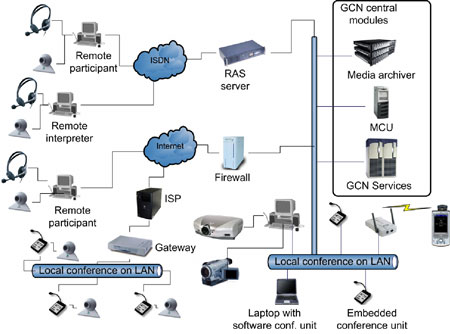
This issue in pdf Subscription Archive: Next issue: October 2005 |
|
||||
Solutions for an Interpreter-Enabled Multimedia Conferencing Systemby Ferenc Sárközy and Géza Haidegger As video conferencing is likely to become a commonplace tool in the near future, a demand may also arise for an interpreter-enabled video conferencing system. Despite the fact that current technology is able to accomplish this, no such product is actually available. The Global Conference Network project aimed at establishing a distributed, multi-lingual, multimedia conferencing system. Research and development work at the CIM Research Laboratory of SZTAKI contributed to this project. Video conferencing has become a widely used tool, since it is available to anyone with a mainstream computer and a broadband (xDSL, cable) Internet connection. Despite telecommunication service parameters having improved remarkably, they still represent a bottleneck in some professional applications of video conferencing systems. Progress in this area has slowed recently, mostly for business-related reasons. Consequently, it is hoped that the market push will make further development probable, as has been the case in Japan. The enhancement of the local loop bandwidth and other QoS (quality of service) parameters can open up the way for such demanding applications as interpreted video conferences (IVC). The Global Conference Network (GCN) system attempts to establish audio and video connections independently from language and actual place of residence. In order to achieve this general goal, GCN has to meet the following requirements:
The most important advantages of an IVC system are the following:
The GCN system has three main functional parts. Firstly, the GCN database (GCNDB) contains all the information about any conferences organized with the help of that GCN system. This is a MySQL database and it is maintained by the GCN Web Server (GCNWS). Secondly, GCNWS is a PHP-based Web application. It provides Web pages that handle the entire life cycle of the conference data, but the emphasis is on pre- and post-conference functionalities. The conference structure is created during the set-up process and after the conference, the GCNWS can be used as an archive viewer. The third part of the GCN system - the GCN Applications (GA) - is an extendable set of applications which interact with each other and with the floor control messages of GCN. The base set of these and their roles are the following:
Our aim was to create a portable solution, so all these components are realized on a Java platform. As most standards and standard protocols in tele- and video-conferencing have some deficiencies, we must also deal with protocol development. The Open H.323 project aims to create an open-source implementation of the H.323 teleconferencing protocol. H.323 and therefore the Open H.323 project offer a solution based on a Multipoint Control Unit (MCU). One of our media-handling solutions is based on this open-source software. Using an MCU leads necessarily to a centralized system. JMF (Java Media Framework) and the VideoLAN project (see below) allow a decentralized, media server-less solution. The requirement is that the underlying network should be multicast-enabled. JMF allowed us to implement a distributed media-handling solution. However, during the implementation, an unforeseen bug in JMF caused some problems.
The Open Source VideoLAN project aims to provide a video and audio streaming tool. One of the result applications of VideoLAN is an open-source program, named ‘VLC’, which is a media-processing unit. It can handle codecs that scale very well, and so works also on low bit-rates. VLC can stream with RTP, either unicast or multicast. VLC itself is a stand-alone application, but offers several possibilities for programmed access to its services. The solutions based on VLC and H.323 worked equally well on a local area network. VLC provides much better quality, but also requires more processing power and is based on a lower level standard. On an entry level ADSL connection (384/128kbps), the upload bandwidth was a serious bottleneck for VLC. In the download direction the bandwidth was sufficient, and both image and sound quality were satisfactory. The H.323-based solution provided the quality that two NetMeeting clients can achieve on this connection. During the modification of the MCU we developed the know-how for the integration of better codecs into the system, and as a consequence the final solution will be based on the H.323 standard. The project leader, DIGITON Ltd, is an innovative Hungarian SME, working on solutions to match future, novel needs. This project inspired new ideas and plans, and the consortium is open to further scientific challenges. Links: Please contact: |
||||


